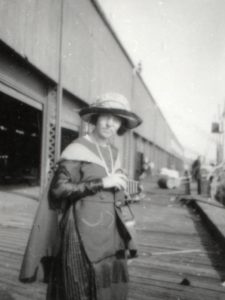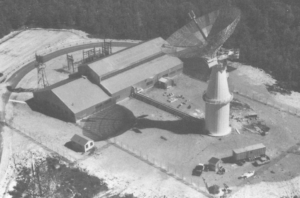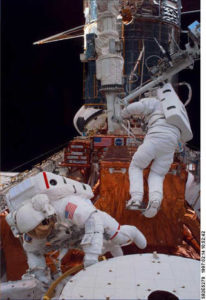
Steven L. Smith, STS-82 mission specialist, on the Remote Manipulator System (RMS) arm with the Faint Object Spectrograph (FOS) after removal from Hubble Space Telescope during the second servicing mission in February 1997. Credit NASA.
February 8
1828: Jules Verne is born

Jules Verne | Étienne Carjat, c. 1884
Jules Verne, a French poet, novelist, and playwright, was born in Nantes, France on February 8, 1828. Verne is best known for his bestselling science fiction novels Journey to the Center of the Earth (1864), Twenty Thousand Leagues Under the Seas (1870), and Around the World in Eighty Days (1872). He is often referred to as “the father of science fiction,” as his works largely pioneered the genre. Astronomy and space exploration were major themes in many of his novels, and his writing helped generate an interest in the sciences among both children and adults. Verne has been the second most-translated author in the world since 1979, ranking between Agatha Christie and William Shakespeare.
1879: Elizabeth Langdon Williams is born

Elizabeth Langdon Williams | Unknown, Public Domain
Elizabeth Langdon Williams was born on February 8, 1879 in Putnam, Connecticut. She was an American human computer and astronomer whose work helped lead to the discovery of Pluto, then referred to as Planet X. Williams was hired to work by Percival Lowell to work from his Boston office in 1905. She was initially tasked with editing Lowell’s publications, but asked to be given the role of a human computer in his search for Planet X. Her request was granted, and she began making calculations to help determine the best locations in the sky to look for the planet.
Lowell passed away in 1916, bringing an end to a majority of the search efforts. However, Williams continued to work on calculations and handled observatory correspondence after his passing. She moved from Boston to Flagstaff to work at Lowell Observatory itself in 1919. There, she met her husband, astronomer George Hall Hamilton. Shortly after they married, however, they were dismissed from their positions by Percival Lowell’s widow Constance, as it was then considered inappropriate to employ a married woman.
The calculations Williams made as head computer in the search for Planet X led to more precise predictions of its location when the project was resumed by Clyde Tombaugh in 1929. Tombaugh used Lowell’s predictions to ultimately locate Planet X—predictions that could not have been made without Williams’s calculations.
February 10
1958: First radar signal returned from Venus detected

The Lincoln Laboratory Millstone Hill Radar Observatory, ca. 1958 | MIT Lincoln Laboratory, Lexington, Massachusetts, photo no. P489-128
MIT’s Lincoln Laboratory in Lexington, MA was the first institution to receive radar waves that had been bounced off the surface of Venus and returned to Earth. The signal was detected by Lincoln Lab’s Millstone Hill radar on February 10, 1958, at the height of the Space Race between Russia and the United States. Though there was initial uncertainty that it was indeed Venus that the signal had been returned by, the results were later confirmed by a similar experiment carried out by the Jet Propulsion Laboratory (JPL) in 1961.
Developments in the field of what is now referred to as planetary radar astronomy, such as the exact value of an astronomical unit (AU) and Earth’s distance from other celestial bodies, were actually not made by astronomers. Rather, they were accomplished by electrical engineers working at military research and development institutions like Lincoln Laboratory. Due to the heightening tensions of the Cold War from the late 1940’s to the early 1990’s, military equipment became more available for research purposes—not only for the development of weapons, but also for discovering new methods of exploring the cosmos.
February 11
1997: Hubble Space Telescope’s 2nd servicing mission starts

NASA astronauts install the NICMOS | NASA
The Hubble Space Telescope’s second servicing mission (referred to as SM2 or STS-82) was launched on February 11, 1997. The crew’s mission was to perform maintenance on the telescope and install science instruments to enhance the its productivity. These new instruments, including the Space Telescope Imaging Spectrograph (STIS) and the Near Infrared Camera and Multi-Object Spectrometer (NICMOS), gave astronomers the ability to view never-before-seen corners of the universe with the very latest in infrared imaging and spectroscopic1 technology.
[vcex_divider color=”#dddddd” width=”100%” height=”1px” margin_top=”20″ margin_bottom=”20″]
1Spectroscopy refers to the study of light wavelengths emitted, reflected or shone through a solid, liquid, or gas. In astronomy, spectroscopy is used to determine the elements that celestial bodies such as stars, planets and nebulae are made of.